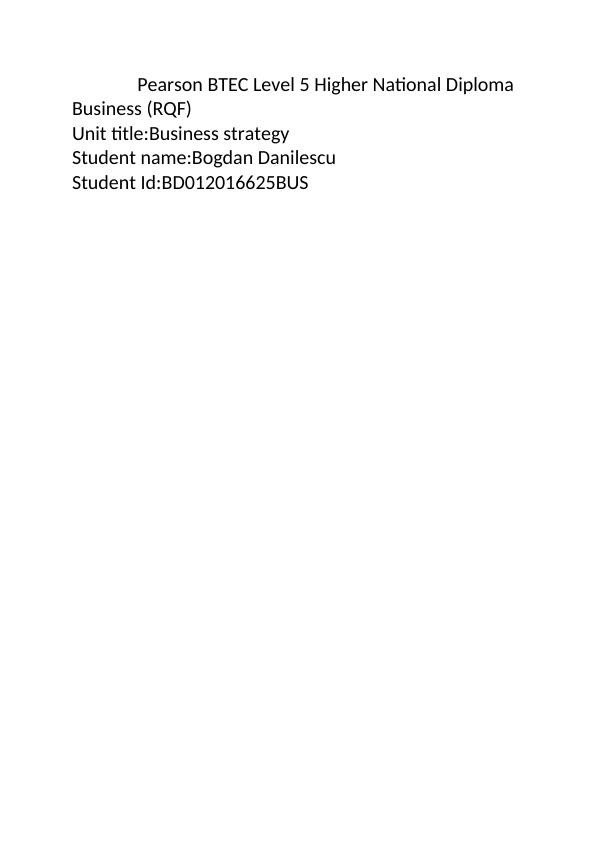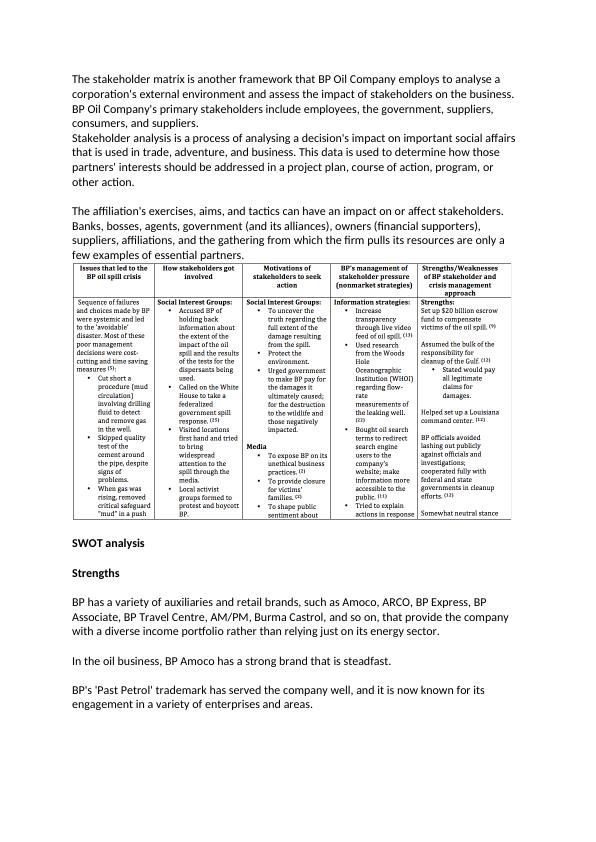Ask a question from expert
Report on Business and Marketing strategy of BP oil
17 Pages5829 Words72 Views
Added on 2021-10-14
About This Document
A corporation can compete in a market by using a combination of tactics, goals, and strategies called a business strategy. Businesses can expand globally and remove obstacles to transnational business activity with the help of business strategy. Corporations can enhance their business operations by using a solid business plan. Business strategy provides direction for an organization's future orientation. BP Oil is the company that has been selected for this investigation. Service stations are operated all around the world by BP Oil, a global British oil and gas company with its headquarters in London.
Report on Business and Marketing strategy of BP oil
Added on 2021-10-14
BookmarkShareRelated Documents
Pearson BTEC Level 5 Higher National Diploma
Business (RQF)
Unit title:Business strategy
Student name:Bogdan Danilescu
Student Id:BD012016625BUS
Business (RQF)
Unit title:Business strategy
Student name:Bogdan Danilescu
Student Id:BD012016625BUS

Business strategy
Introduction on BP oil strategy
A business strategy is a combination of strategies, actions, and goals that enable a company
compete in a certain market. Business strategy aids companies in expanding globally and
overcoming barriers to performing cross-border commercial activity. With the use of a good
business plan, corporations can improve their business operations. Business strategy gives
an organization's future orientation a sense of direction. The business firm chosen for this
research is BP Oil. BP Oil is a multinational British oil and gas firm based in London that runs
service stations all over the world. The current paper examines the impact of the macro
environment on BP and analyses the company's internal strengths. In addition, in this paper,
Porter's five forces model is applied to BP. The strategic directions of BP are examined in
this paper using appropriate models.
Macro Environment
Political and social dependability are intriguing aspects to identify and measure in a way that
may be used as an econometric study. Political insecurity is linked to the insecurity of
governments, organizations, and gatherings inside a country. The compressed defeat of
existing force, or a high possibility of intended departure, from non-sacred topples d'état,
productive or otherwise, is a compelling example. Change is something that happens all the
time. Non-established expulsion may appear improbable in the United Kingdom. However, a
concentrated effort to replace the leadership is associated with vulnerabilities in the
approaches and, in exceptional situations, with threats to property rights. Property rights
are, in general, viewed as establishments of significant importance to the financial turn of
events, reducing instability and exchange costs associated with economic activities. Swelling
rates have been extremely variable up to this point. The finer points are as follows:
As a result of more cheaper gasoline and lower energy prices, the UK's rate of expansion
slowed to a new low in December, according to official figures. According to the Workplace
for Public Measurements, swell as measured by the Purchaser Costs File reduced to 0.5
percent a month ago, down from 1 percent in November. According to the ONS authority,
the last time year-to-month expansion was this low was in May 2019. The rate of rise in the
Retail Costs List (RPI), which was unexpectedly calculated, also continued in a downward
trend, falling to 1.6 percent from 2 percent.
Lately, the rate of expansion has shifted dramatically. Costs were increasing at a yearly rate
of roughly 5% in 2020, as the overall monetary situation began to take impact. In any event,
expenses were moving by roughly 1% on the CPI measure, and were genuinely reducing by
roughly 1.5 percent on the RPI measure, less than a year later. Costs were rising again by
late 2020, with the CPI at 5.2 percent, matching the all-time high achieved in September. RPI
increased to 5.6 percent, the highest annual rate since June 1991. Since then, both metrics
Introduction on BP oil strategy
A business strategy is a combination of strategies, actions, and goals that enable a company
compete in a certain market. Business strategy aids companies in expanding globally and
overcoming barriers to performing cross-border commercial activity. With the use of a good
business plan, corporations can improve their business operations. Business strategy gives
an organization's future orientation a sense of direction. The business firm chosen for this
research is BP Oil. BP Oil is a multinational British oil and gas firm based in London that runs
service stations all over the world. The current paper examines the impact of the macro
environment on BP and analyses the company's internal strengths. In addition, in this paper,
Porter's five forces model is applied to BP. The strategic directions of BP are examined in
this paper using appropriate models.
Macro Environment
Political and social dependability are intriguing aspects to identify and measure in a way that
may be used as an econometric study. Political insecurity is linked to the insecurity of
governments, organizations, and gatherings inside a country. The compressed defeat of
existing force, or a high possibility of intended departure, from non-sacred topples d'état,
productive or otherwise, is a compelling example. Change is something that happens all the
time. Non-established expulsion may appear improbable in the United Kingdom. However, a
concentrated effort to replace the leadership is associated with vulnerabilities in the
approaches and, in exceptional situations, with threats to property rights. Property rights
are, in general, viewed as establishments of significant importance to the financial turn of
events, reducing instability and exchange costs associated with economic activities. Swelling
rates have been extremely variable up to this point. The finer points are as follows:
As a result of more cheaper gasoline and lower energy prices, the UK's rate of expansion
slowed to a new low in December, according to official figures. According to the Workplace
for Public Measurements, swell as measured by the Purchaser Costs File reduced to 0.5
percent a month ago, down from 1 percent in November. According to the ONS authority,
the last time year-to-month expansion was this low was in May 2019. The rate of rise in the
Retail Costs List (RPI), which was unexpectedly calculated, also continued in a downward
trend, falling to 1.6 percent from 2 percent.
Lately, the rate of expansion has shifted dramatically. Costs were increasing at a yearly rate
of roughly 5% in 2020, as the overall monetary situation began to take impact. In any event,
expenses were moving by roughly 1% on the CPI measure, and were genuinely reducing by
roughly 1.5 percent on the RPI measure, less than a year later. Costs were rising again by
late 2020, with the CPI at 5.2 percent, matching the all-time high achieved in September. RPI
increased to 5.6 percent, the highest annual rate since June 1991. Since then, both metrics

have slid back, with CPI now falling below the Bank of England's 2% goal rate for the first
time since November 2009.
BP oil was subjected to a PESTLE examination.
Political Economic Social Technology Legal Environment
Security of
future
energy
supplies
Present EU’s
high
dependence
on Russia
Increase in
energy prices
Iraq
Rising
domestic
energy
prices
Electricity
and petrol
prices
Technology
for reducing
Greenhouse
petrol
emissions
Carbon
capture
Taxation
and fuel
duty
(1993)
Affected
prices
Climate
change
Efforts to
reduce
greenhouse
gases
emissions
Politics of
climate
change
Greenhouse
petrol
emission
reduction
Political
instability
Demands
from India
and China
Marketing
of petrol
and
electricity
Choice of
suppliers
Processes of
burning oil
for heating
Renewabl
e
transport
fuel
Obligation
(2005)
Use of bio-
fuels
Infrastructure
costs due to
environmenta
l issues
Terrorist
activities
Investments
in Oil and
petrol
production
Government
assistance
with fuel
bills
Winter fuel
payment
Oil and petrol
production
methods
Sub-sea
technology
improvement
EU
Emissions
trading
scheme
Carbon
emission
allowance
s
Environmenta
l groups
Joint
approach to
green issues
Risk of
terrorist
attacks on
energy
supplies &
infrastructur
e
Investment
in
infrastructur
e
To ensure
sufficient
capacity and
flexibility
Climate
change and
energy
conservatio
n
Wide range
of
technological
development
s
Licensing
rounds for
the UK
offshore
oil
Increase in
popularity of
nuclear
power
Interest
rates,
exchange
rates and
inflation
rates
Home
insulation
Efficient use
of heat
Technologies
skills
Stakeholders analysis
time since November 2009.
BP oil was subjected to a PESTLE examination.
Political Economic Social Technology Legal Environment
Security of
future
energy
supplies
Present EU’s
high
dependence
on Russia
Increase in
energy prices
Iraq
Rising
domestic
energy
prices
Electricity
and petrol
prices
Technology
for reducing
Greenhouse
petrol
emissions
Carbon
capture
Taxation
and fuel
duty
(1993)
Affected
prices
Climate
change
Efforts to
reduce
greenhouse
gases
emissions
Politics of
climate
change
Greenhouse
petrol
emission
reduction
Political
instability
Demands
from India
and China
Marketing
of petrol
and
electricity
Choice of
suppliers
Processes of
burning oil
for heating
Renewabl
e
transport
fuel
Obligation
(2005)
Use of bio-
fuels
Infrastructure
costs due to
environmenta
l issues
Terrorist
activities
Investments
in Oil and
petrol
production
Government
assistance
with fuel
bills
Winter fuel
payment
Oil and petrol
production
methods
Sub-sea
technology
improvement
EU
Emissions
trading
scheme
Carbon
emission
allowance
s
Environmenta
l groups
Joint
approach to
green issues
Risk of
terrorist
attacks on
energy
supplies &
infrastructur
e
Investment
in
infrastructur
e
To ensure
sufficient
capacity and
flexibility
Climate
change and
energy
conservatio
n
Wide range
of
technological
development
s
Licensing
rounds for
the UK
offshore
oil
Increase in
popularity of
nuclear
power
Interest
rates,
exchange
rates and
inflation
rates
Home
insulation
Efficient use
of heat
Technologies
skills
Stakeholders analysis

The stakeholder matrix is another framework that BP Oil Company employs to analyse a
corporation's external environment and assess the impact of stakeholders on the business.
BP Oil Company's primary stakeholders include employees, the government, suppliers,
consumers, and suppliers.
Stakeholder analysis is a process of analysing a decision's impact on important social affairs
that is used in trade, adventure, and business. This data is used to determine how those
partners' interests should be addressed in a project plan, course of action, program, or
other action.
The affiliation's exercises, aims, and tactics can have an impact on or affect stakeholders.
Banks, bosses, agents, government (and its alliances), owners (financial supporters),
suppliers, affiliations, and the gathering from which the firm pulls its resources are only a
few examples of essential partners.
SWOT analysis
Strengths
BP has a variety of auxiliaries and retail brands, such as Amoco, ARCO, BP Express, BP
Associate, BP Travel Centre, AM/PM, Burma Castrol, and so on, that provide the company
with a diverse income portfolio rather than relying just on its energy sector.
In the oil business, BP Amoco has a strong brand that is steadfast.
BP's 'Past Petrol' trademark has served the company well, and it is now known for its
engagement in a variety of enterprises and areas.
corporation's external environment and assess the impact of stakeholders on the business.
BP Oil Company's primary stakeholders include employees, the government, suppliers,
consumers, and suppliers.
Stakeholder analysis is a process of analysing a decision's impact on important social affairs
that is used in trade, adventure, and business. This data is used to determine how those
partners' interests should be addressed in a project plan, course of action, program, or
other action.
The affiliation's exercises, aims, and tactics can have an impact on or affect stakeholders.
Banks, bosses, agents, government (and its alliances), owners (financial supporters),
suppliers, affiliations, and the gathering from which the firm pulls its resources are only a
few examples of essential partners.
SWOT analysis
Strengths
BP has a variety of auxiliaries and retail brands, such as Amoco, ARCO, BP Express, BP
Associate, BP Travel Centre, AM/PM, Burma Castrol, and so on, that provide the company
with a diverse income portfolio rather than relying just on its energy sector.
In the oil business, BP Amoco has a strong brand that is steadfast.
BP's 'Past Petrol' trademark has served the company well, and it is now known for its
engagement in a variety of enterprises and areas.

End of preview
Want to access all the pages? Upload your documents or become a member.